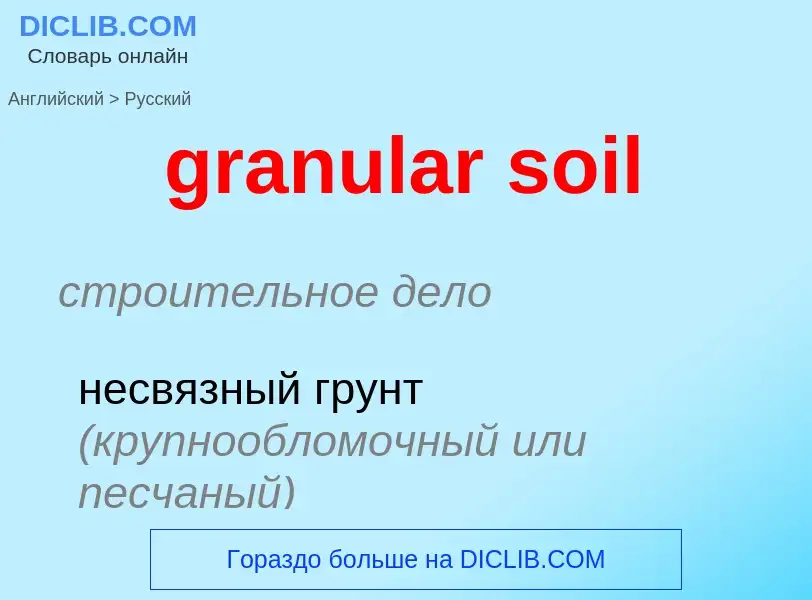Перевод и анализ слов искусственным интеллектом ChatGPT
На этой странице Вы можете получить подробный анализ слова или словосочетания, произведенный с помощью лучшей на сегодняшний день технологии искусственного интеллекта:
- как употребляется слово
- частота употребления
- используется оно чаще в устной или письменной речи
- варианты перевода слова
- примеры употребления (несколько фраз с переводом)
- этимология
granular soil - перевод на русский
строительное дело
несвязный грунт (крупнообломочный или песчаный)
[sɔil]
общая лексика
почва
грунт
земля
почвенный слой
почвенный
вымарать
вымарывать
гадить
грунтовой
загрязнять
пескальный
пескальный грунт
строительное дело
почва, грунт
грунтовое основание
грунт основания
сточная жидкость
бытовые сточные воды, фекальные стоки
нефтегазовая промышленность
почвогрунт
существительное
[sɔil]
общая лексика
почва
грунт
земля
страна
грязь
пятно
экскременты
нечистоты
отбросы
навоз
компост
почва, земля
охота
болото или ручей
где прячется загнанное животное
глагол
общая лексика
пачкать
грязнить
марать
покрывать пятнами
пачкаться
грязниться
мараться
порочить
осквернять
бесчестить
тускнеть
валяться в грязи
плескаться в воде (о животных)
пачкать(ся), грязнить(ся)
давать скоту зеленый корм
охота
спасаться от преследования в болоте или в воде (о животных)
сельское хозяйство
унавоживать
удобрять
давать скоту зелёный корм
в переносном значении
запятнать
синоним
антоним
Определение
Википедия
A granular material is a conglomeration of discrete solid, macroscopic particles characterized by a loss of energy whenever the particles interact (the most common example would be friction when grains collide). The constituents that compose granular material are large enough such that they are not subject to thermal motion fluctuations. Thus, the lower size limit for grains in granular material is about 1 μm. On the upper size limit, the physics of granular materials may be applied to ice floes where the individual grains are icebergs and to asteroid belts of the Solar System with individual grains being asteroids.
Some examples of granular materials are snow, nuts, coal, sand, rice, coffee, corn flakes, fertilizer, and bearing balls. Research into granular materials is thus directly applicable and goes back at least to Charles-Augustin de Coulomb, whose law of friction was originally stated for granular materials. Granular materials are commercially important in applications as diverse as pharmaceutical industry, agriculture, and energy production.
Powders are a special class of granular material due to their small particle size, which makes them more cohesive and more easily suspended in a gas.
The soldier/physicist Brigadier Ralph Alger Bagnold was an early pioneer of the physics of granular matter and whose book The Physics of Blown Sand and Desert Dunes remains an important reference to this day. According to material scientist Patrick Richard, "Granular materials are ubiquitous in nature and are the second-most manipulated material in industry (the first one is water)".
In some sense, granular materials do not constitute a single phase of matter but have characteristics reminiscent of solids, liquids, or gases depending on the average energy per grain. However, in each of these states, granular materials also exhibit properties that are unique.
Granular materials also exhibit a wide range of pattern forming behaviors when excited (e.g. vibrated or allowed to flow). As such granular materials under excitation can be thought of as an example of a complex system. They also display fluid-based instabilities and phenomena such as Magnus effect.



.jpg?width=200)

.jpg?width=200)
![TJ Taylor]] TJ Taylor]]](https://commons.wikimedia.org/wiki/Special:FilePath/Thumb 21160088-16BA-46E2-A605-8274E164C378.jpg?width=200)
